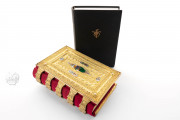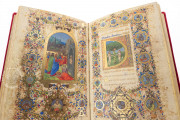The Prayer Book of Lorenzo de' Medici is one of the most elegant Renaissance manuscripts from the mid-west area of Italy. The codex, also known as Gebetbuch des Lorenzo de' Medici, was written and illuminated in the last quarter of the fifteenth century in Florence – notoriously known as the hometown of the Medici family – and it features ten skillfully illuminated full-page miniatures, twelve small-format calendar illuminations, and seven historiated initials.
The Prayer book of Lorenzo de' Medici and the Artistry of Francesco Rosselli
The iconographic apparatus of the codex is the work of Francesco Rosselli (1455-1513), younger brother of the Florentine painter Cosimo Rosselli – famously known for his frescoes in the Sistine chapel. The younger brother was the favorite miniaturist of the Medici so the choice of the artist is hardly surprising.
The Beautiful and Elaborate Border Decorations
Border decorations feature lovely painted fruit, festoons, animals, flowers, candelabra, putti, and images inserted in medallions, echoing the motifs of the work of goldsmiths. The colors are used in a luminous but subdued way, creating an elegant balance between gleaming gold and dark colors such as blue, mainly used for the depiction of serene landscapes. The full-page miniatures and the borders are painted in an harmonious manner exhibiting each page as an organic whole.
Each miniature is faced with a page containing an introductory text and a historiated initial. An example of such iconographic and conceptual coherency are fols. 13v-14r which respectively depict the scene of the Annunciation on one side and the half-length figure of the Virgin and Child inhabiting a large-scale letter D on the other (historiated initial).
Famous and Powerful Commissioner
It seems certain that the commissioner of the manuscript was Lorenzo de' Medici (Lorenzo the Magnificent) due to the presence of the motto semper and tiny putti holding the coats of arms of the Medici dynasty. Furthermore, the codex was created as a present in occasion of Lucrezia and Jacopo Salvati's wedding in 1488, Lucrezia being his eldest daughter.
Antonio Sebaldi and His Humanistic Script
The codex appears in the inventory of the dukes of Wittelsbach in 1598, becoming part of the collection of the Court Library in Munich in 1785. The script of the Prayer book of Lorenzo de' Medici constitutes an important masterpiece also due to its scribe. A signature can be found in fol. 223r informing the reader that the scribe of the work was Antonio Sinibaldi, popular for his beautifully elegant handwriting.
The codex features a clear and elegant littera humanistica, exhibiting a decrease of ligatures and a very limited presence of abbreviations as opposed to the Gothic script.
The codex' enamel inlays have survived until modern times.
We have 1 facsimile edition of the manuscript "Prayer Book of Lorenzo de' Medici": Gebetbuch Lorenzos de' Medici 1485 facsimile edition, published by Mueller & Schindler, 1991
Request Info / Price















